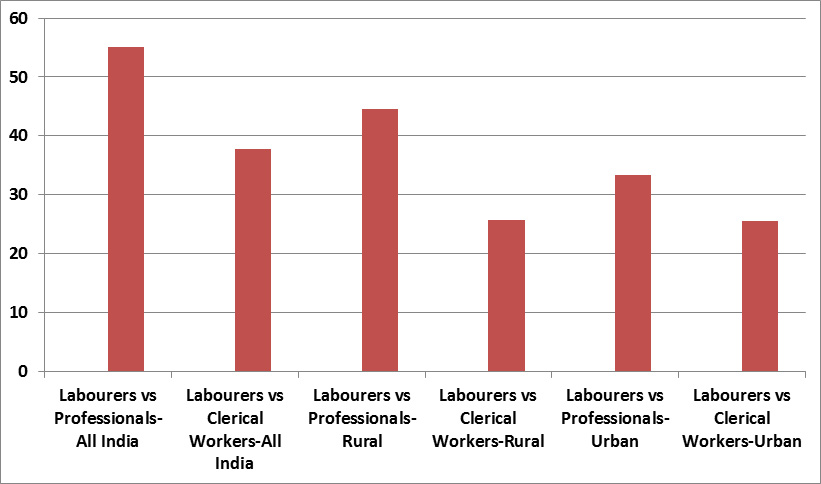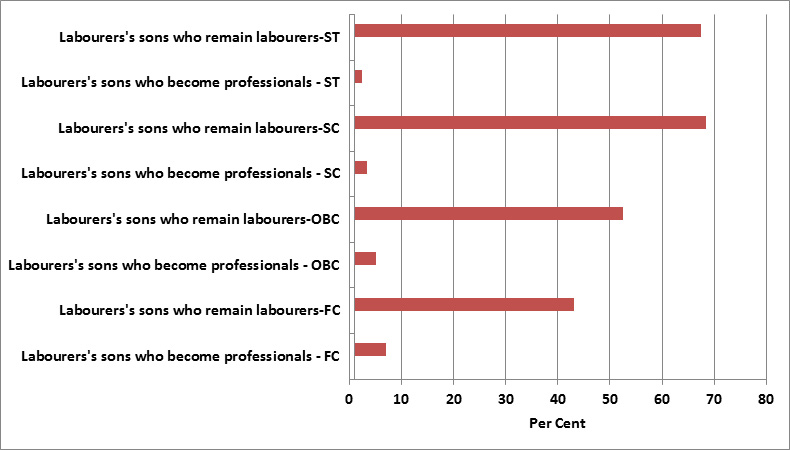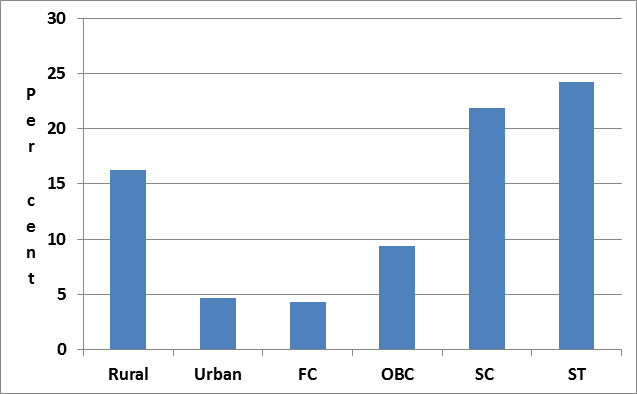To what extent is an individual’s status in society determined by the position of his or her parents? Analysing data from the Indian Human Development Survey, 2011-2012, this column finds that the probability of large intergenerational, occupational ascents in India is very low, and in fact, many face high risk of downward mobility.
A question of long-standing interest among social scientists is the degree to which an individual’s status in society is determined by the position of his or her parents. In egalitarian societies, where you are on the social and economic status ladder, should not be principally determined by your parents’ income, educational level, social status, or occupation. Social mobility research has been concerned with intergenerational mobility, but much of this work has concentrated on advanced market economies. However, this issue is of crucial importance in the developing world, and especially in emerging economies that have undergone modernisation as they have opened up to the world economy in recent decades, and along with growth, have experienced rising inequality.
We look at occupational mobility in the context of India, a country which has witnessed rapid economic, political and social change since the 1980s, using a nationally representative dataset – the Indian Human Development Survey (IHDS). The IHDS, 2011-2012 has detailed information on the occupations of fathers and sons (unfortunately for us, comparable information about mothers and daughters is not available in this database)1.
Our analysis differs from previous work in two important respects. First, we use a finer-grained categorisation that takes into account differences in skill levels across different occupations as well as their place in India’s social hierarchy of labour. Second, we examine both large and moderate occupational ascents and descents – that is, both large and not-so-large movements up or down the social status ladder (while small ascents and descents have been more extensively examined, including by us, investigations of large ascents in the developing world are only just commencing). We also compare the patterns we deduce for India with occupational mobility in other countries and at other times.
Upward mobility prospects
Overall, the probability of large intergenerational ascents in India is very low. Dividing the population into six occupational categories arranged from the highest (professionals) to the lowest (manual labourers) (see Table 1) we find that the odds ratio of a labourer’s son remaining a labourer rather than becoming a professional (as compared to a professional’s son becoming a labourer rather than remaining a professional) was 55 in the all-India sample (Figure 1). This means that a professional’s son was more than 50 times as likely to rise to the highest occupational category as the son of a labourer. We also find that the odds ratio of a labourer’s son remaining a labourer rather than becoming a clerical worker (the second-highest occupational category, just below professional) when compared to a clerical worker’s son becoming a labourer rather than remaining a clerical worker was slightly better, but still very high (38).
Table 1. Occupational categories and codes
| Category 6 | Professionals |
| Category 5 | Clerical workers |
| Category 4 | Farmers |
| Category 3 | Higher-status vocational occupations |
| Category 2 | Lower-status vocational occupations (often caste-based; traditional) |
| Category 1 | Agricultural and other manual labourers, including construction workers |
Figure 1. Odds ratios of upward mobility

There is a higher degree of social mobility among urban residents, with the odds ratio of a labourer’s son remaining a labourer rather than becoming a professional (as compared to a professional’s son becoming a labourer rather than remaining a professional) being 33 in urban areas, compared to 45 for rural residents.
More disturbingly, we find significant differences in social mobility by social group. As is well-known, Dalits (or Scheduled Castes (SCs)) and especially Adivasis (or Scheduled Tribes (STs)) are the most disadvantaged social groups in India. Combined with their high rates of poverty, very low rates of social mobility prevail among these social groups. For instance, we find that among forward castes, 7.1% of labourers’ sons become professionals, and 43.1% of labourers’ sons remain labourers (Figure 2). In contrast, among Other Backward Classes (OBCs), 5.1% of labourers’ sons become professionals, while 52.6% of labourers’ sons remained labourers. Among SCs, however, only 3.3% of labourers’ sons become professionals, while a staggering 68.4% of labourers’ sons remained labourers2. Similarly, among STs, only 2.5% of labourers’ sons become professionals, while 67.5% of labourers’ sons remain labourers. Significant barriers to social and occupational mobility still persist in India’s most disadvantaged social groups in spite of long-standing affirmative action programmes and intense political mobilisation of these groups since independence.
Figure 2. Upward mobility prospects

Downward mobility risks
We also find much higher risks of downward mobility among rural residents as compared to urban, and among SC and STs compared to forward castes. The percentage of sons of professional fathers who become labourers is 16.3 in rural areas and 4.7 in urban areas (Figure 3). Only 4.3% of sons of forward caste professionals became manual labourers, compared to 9.4% of OBC professionals’ sons. In contrast, a remarkable 21.9% of the sons of SC professional fathers become labourers and 24.2% of the sons of ST professional fathers become labourers.
Figure 3. Downward mobility risks: % of sons of professionals who become labourers

Social mobility in India: 2011-2012 vs. 2004-2005
How do our estimates of social mobility for 2011-2012 compare to an earlier period? IHDS data is also available for 2004-2005, and when we compare social mobility in 2004-2005 with 2011-12, we uncover a mixed picture. On the one hand, there is evidence of greater occupational mobility among individuals in the lowest ranked occupational category in 2011-2012 compared to 2004-2005. While in 2004-2005, 11.5% of the sons of agricultural and other labourers in the all-India sample became clerical workers or professionals, the corresponding number for 2011-2012 is 15.6%. On the other hand, there is less mobility in the second lowest ranked occupational category – the percentage of sons of fathers in lower skilled occupation who entered the highest two occupational categories in 2011-2012 was 21.6% as compared to 29.8% in 2004-2005. There is no clear evidence that the low level of upward mobility in India has begun to increase as a result of economic growth.
Social mobility in India vs. other countries
How does social mobility in India compare to other transitional or developing economies and, historically, to countries that are now industrialised? Standardised databases and comparable indices do not exist that enable head-to-head comparisons. We considered the question in a preliminary fashion by looking at simple (and coarse) comparisons with Victorian Britain and contemporary China. First, comparing contemporary India with Victorian England, the archetype of a rigid social structure and upper class privilege, we find that large ascents (into the two topmost categories) for sons of manual labourers were less frequent in Victorian Britain than in contemporary India (Miles 1999). In contrast, modest ascents were about twice as common as in contemporary, rural India, but less common than in India’s cities. The picture, therefore, is mixed.
How do contemporary India and China compare? The first studies of occupational mobility in China suggested a seemingly unprecedented disconnect between parent and offspring occupations, but these early studies, which focused on Hong Kong and Tianjin, are compromised by severe sample selection bias (Wu and Treiman 2007)3. There are data limitations for China, too, but what emerges from the broad-brush approach that we take, is that there are compelling and unique similarities in occupational mobility patterns between Asia’s two giants. While in India, location and social identity are key determinants of large ascent prospects, upward mobility prospects in China are circumscribed by the hukou or household registration system, introduced by the Chinese government to control rural-urban population movements. Further, urban hukou status has been bestowed selectively on individuals of rural background with exceptional educational achievements. When we consider the entire population in China, we find remarkable similarities in the upward mobility prospects of manual labourers in China and India, with less than 10% of such workers’ sons becoming professionals in either country. However, there is much higher upward mobility prospects for sons of agricultural workers who hold urban hukou status in China, with around 30% of such sons rising to become professionals (Wu and Treiman 2007). It is tempting to conclude that the privileged in China appear to be more privileged than India’s forward castes – showing how policy can have a big effect upon individuals’ social mobility prospects. Probing the differences in social mobility among China, India and other developing countries is an important task, requiring more in-depth future investigations using much tighter comparisons than we are able to provide here.
Key findings and implications
Our findings seem to provide general support to the assertion by Bardhan (2010) that India compares poorly to other countries in terms of opportunities for upward mobility. There is also a great risk of downward mobility in India as well as China. In India, vast differences exist in the upward mobility prospects of urban versus rural residents and forward castes versus SCs and STs. The combination of these trends makes for a precarious existence for many Indians – with low upward and high downward mobility being experienced by many, especially SCs, STs, and rural residents.
Reversing these trends is essential for a just society (Roemer 1998). Affirmative action in its current form isn’t all that is necessary: the fact that SC and ST offspring of professional fathers are at much higher risk of large occupational descents suggests that sustaining occupational achievements is harder for minority households. More sweeping remedial measures, starting with primary school and earlier, are required (as discussed extensively in Krishna 2017), some of which are being taken up on small scale by pioneering NGOs.
Notes:
- An earlier paper that looks at social mobility in India using IHDS, 2004-2005 is Motiram and Singh (2012).
- A caveat here is that we are not testing for average differences across social groups, and the numbers of observations in some of the cells of the occupational mobility matrices are quite small.
- Residents of these two cities are more likely to observe higher social mobility than the rest of the country.
Courtesy : Vegard Iversen (Indian Institute of Management, Ahmedabad), Anirudh Krishna (Duke University) , Kunal Sen (UNU-WIDER).

